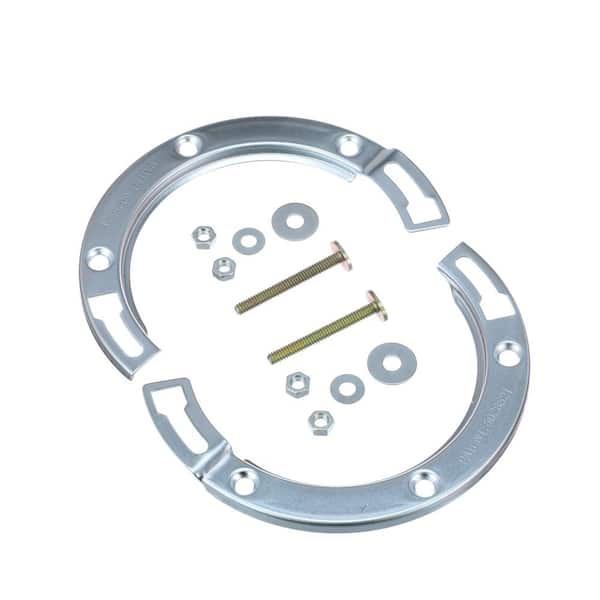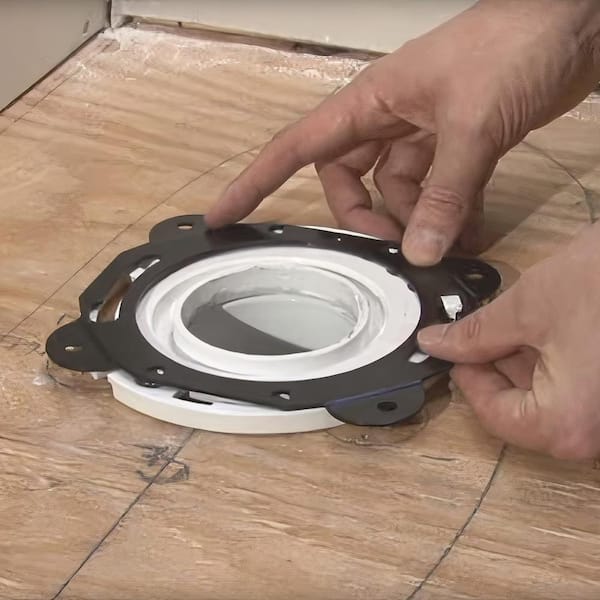Just how do you actually feel about Fix a Broken Toilet Flange?

Intro:
Understanding the Importance of a Toilet Flange:
In the world of plumbing, the often-overlooked commode flange plays an essential function in ensuring the seamless procedure of your bathroom fixtures. As an important connector in between your toilet and the underlying drain, the toilet flange works as the unsung hero of your plumbing system. Without this tough element, your commode would be prone to instability and leakages, potentially bring about expensive repair work and aggravation. Therefore, comprehending the importance of an appropriately installed and kept bathroom flange is paramount for any kind of homeowner starting plumbing jobs or dealing with fixing needs.
Why Proper Installation and Maintenance Matter:
Correct setup and meticulous maintenance of the toilet flange are vital for safeguarding the integrity of your plumbing framework. A meticulously set up flange not just supports your toilet securely in place yet additionally develops a bulletproof seal, fending off the dangers of leakages and smells. By embracing an aggressive method to flange upkeep, you can alleviate the risk of turbulent plumbing issues and preserve the serenity of your home setting. Throughout this insightful overview, we'll decipher the details of toilet flange setup and fixing, empowering you with the understanding and competence to browse these essential tasks expertly.
Best Practices When Installing a Toilet Flange:
Making certain a smooth commode flange installation requires adherence to a set of finest methods that assure durability and functionality. Begin by meticulously assessing your devices and products, guaranteeing you have the needed tools for the job in advance. Selecting the suitable flange product, whether PVC, ABS, or cast iron, is extremely important, as it determines the durability and performance of your plumbing component. In addition, examining existing plumbing problems, such as checking for damage or corrosion, is vital for preemptively attending to prospective problems and ensuring a smooth installation process. By embracing these primary steps, you set a solid foundation for an effective bathroom flange installation, minimising the likelihood of future concerns and facilitating lasting upkeep.
When appropriately prepared, wage the careful removal of the old flange, adhering to a systematic approach to prevent creating damages to surrounding components. Utilize strategies customized to resolve persistent or rusted flanges, guaranteeing their swift and safe removal without compromising the honesty of the bordering plumbing framework. With the old flange got rid of, thoroughly install the brand-new replacement flange, picking one that fits comfortably and securely into location. Effectively securing the flange to the floor utilizing screws or adhesive is critical, as it ensures security and protects against future leaks. By sticking to these best techniques during the setup procedure, you prepared for a robust and dependable bathroom flange arrangement that endures the examination of time.
Mounting a New Toilet Flange:
When setting up a brand-new toilet flange, the first step is to select the appropriate substitute for your plumbing setup. Consider aspects such as the material of the flange, with choices consisting of PVC, ABS, or cast iron. PVC flanges are known for their affordability and resistance to rust, making them a preferred selection for DIY enthusiasts. ABS flanges offer comparable advantages to PVC however boast added durability, making them suitable for high-traffic areas or business setups. Cast iron flanges, renowned for their stamina and long life, are excellent for installments where toughness is vital. Furthermore, ensure that the replacement flange is effectively sized and fits well into place to create a leak-proof seal and avoid leaks.
Protecting the Flange to the Floor:
When you've selected the appropriate replacement flange, it's important to secure it properly to the floor to guarantee security and prevent future concerns. Begin by placing and aligning the flange correctly over the drain, making certain that it rests flush with the flooring surface. Depending on the sort of flange and your particular installation choices, you can protect the flange to the flooring utilizing screws or adhesive. If utilizing screws, make sure to use corrosion-resistant alternatives to avoid rusting gradually. Conversely, adhesive can provide a protected bond between the flange and the flooring, making certain a strong and trustworthy setup. By adhering to these steps and taking the required safety measures, you can mount a new commode flange with self-confidence, making sure a long-lasting and leak-free plumbing component.
Best Practices When Repairing a Broken Flange:
Fixing a broken bathroom flange needs precise focus to detail and adherence to finest techniques to guarantee a long-term solution. Begin by completely analyzing the extent of the damage and determining the underlying cause, whether it be rust, fractures, or imbalance. This analysis will certainly guide your repair work technique, allowing you to select the most suitable techniques and materials for restoring the flange to its optimum problem. In addition, think about the surrounding plumbing framework and flooring stability to address any kind of possible contributing factors and stop future issues from developing. By performing a thorough evaluation and analysis, you lay the groundwork for a reliable and enduring repair procedure that settles the origin of the trouble.
With a clear understanding of the flange's condition and the variables influencing its damage, wage the fixing process using accuracy and care. Relying on the extent of the damage, you may select repair techniques such as epoxy putty, repair service flange packages, or partial flange replacements. Guarantee that the picked repair method efficiently attends to the details concerns handy while preserving the architectural integrity and functionality of the flange. In addition, take aggressive procedures to strengthen the repaired flange and prevent future damages, such as using sealer or waterproofing materials to safeguard versus leaks and corrosion. By sticking to these best techniques throughout the repair procedure, you can recover your broken flange to optimum condition, guaranteeing the lasting dependability and efficiency of your plumbing system.
Types of Toilet Flanges:
Understanding the different types of bathroom flanges is essential for choosing one of the most suitable choice for your plumbing needs. PVC, ABS, and cast iron are among the common products used in toilet flange construction, each offering distinct advantages and considerations. PVC flanges, known for their price and corrosion resistance, are favoured for their convenience of installment and toughness. Abdominal muscle flanges, similar to PVC in terms of affordability and ease of installation, are treasured for their effectiveness and resistance to influences. On the other hand, cast iron flanges, renowned for their exceptional toughness and long life, are often preferred for high-traffic locations or industrial settings where resilience is extremely important. By familiarising on your own with the attributes of each material, you can make an educated decision when picking a bathroom flange that straightens with your certain requirements and preferences.
Along with product considerations, commode flanges likewise can be found in different design and styles to accommodate different plumbing setups and installment preferences. Offset flanges, for instance, are made to accommodate bathrooms set up on floorings that are uneven or where the drain lies off-centre. In a similar way, repair flanges, also known as repair work rings or spacer rings, are utilized to attend to problems such as split or broken flanges without the demand for considerable plumbing modifications. Additionally, flexible flanges offer flexibility in positioning, enabling specific alignment and fit throughout setup. By discovering the diverse range of toilet flange kinds and styles readily available, you can pick the option that best fits your plumbing arrangement and installment needs, making certain a smooth and dependable remedy for your restroom components.
Specialty Options:
In addition to typical toilet flanges, there are specialized alternatives readily available to deal with details plumbing challenges and installation preferences. One such choice is the countered flange, which is made to accommodate bathrooms mounted on floorings that are uneven or where the waste pipe is located off-centre. Offset flanges feature a distinct style that enables the commode to be placed at a mild angle, making up for unequal flooring or misaligned plumbing connections. This innovative solution ensures a safe and secure and stable installation, removing the requirement for costly and taxing flooring leveling or pipeline relocation. By including a countered flange right into your plumbing setup, you can conquer common setup obstacles and attain a professional-quality result with ease.
One more specialty alternative worth taking into consideration is the repair work flange, likewise known as a repair work ring or spacer ring. Repair flanges are specifically created to address problems such as split or damaged toilet flanges without the need for substantial plumbing alterations. These flexible elements can be mounted straight over the existing flange, giving a tough and dependable base for securing the toilet in place. Repair flanges come in numerous dimensions and arrangements to fit different flange diameters and installation needs, making them a hassle-free and economical service for dealing with flange-related problems. Whether you're managing a minor flange repair or an extra complicated plumbing issue, integrating specialty choices like countered and repair service flanges can streamline the setup procedure and guarantee resilient performance for your bathroom components.
Verdict:
To conclude, mastering the art of commode flange setup and repair service is essential for preserving a practical and leak-free plumbing system in your house. By recognizing the value of an effectively set up flange and adhering to best techniques throughout the procedure, you can make certain the longevity and reliability of your bathroom components. Whether you're selecting the appropriate type of flange, carrying out repair services, or checking out specialty options, attention to information and thorough implementation are essential. Regular upkeep and positive troubleshooting can aid stop costly plumbing concerns and preserve the peace of your home environment. Armed with the knowledge and abilities gained from this detailed guide, you can deal with bathroom flange installment and fixing with self-confidence, empowering you to secure your plumbing system for years ahead.
How to Replace a Toilet Flange: A Step-by-Step Guide
A toilet flange serves as the interface between the bottom of the toilet and the drainage pipe. Typically made from PVC, rubber, cast iron, or metal, it provides a secure mounting point to anchor the toilet to the floor and ensures a watertight connection.
The flange features a ring with bolt slots to secure the toilet and a sleeve that fits into the drain pipe. When installed correctly, it maintains a sanitary and odor-free bathroom by directing waste and water efficiently into the sewage system.
What Happens When a Toilet Flange Is Installed Incorrectly?
Water leakage every time the toilet is flushed, which can damage your floor, subfloor, and even the ceiling below. Unpleasant odors due to sewage gas escaping into your home. Mold and mildew growth, compromising indoor air quality. Toilet instability — rocking or moving — breaking the wax seal or further damaging the flange. Symptoms of a Bad Toilet Flange
Water Leaking at the Base: Water pooling around the toilet base after flushing is a telltale sign that your flange needs replacing, especially if the water is dirty. Unstable Toilet: A rocking or moving toilet may have a damaged flange. Foul Odors: Sewage gas smells like rotten eggs, and if you smell it in your bathroom, you likely have a broken seal around your toilet. Visible Damage: Cracks or corrosion on your flange indicate it’s time for a replacement. Remove the Toilet Bowl
Turn off the water supply and flush the toilet to empty the tank. Use a wrench to disconnect the water supply line. Carefully remove the toilet bowl. Clear the Old Wax Ring
Use a putty knife to scrape the old wax ring from the flange and bottom of the toilet. Ensure a clean and smooth surface for the new wax ring. Detach the Damaged Flange
Inspect the flange for any visible damage. Use a wrench to loosen and remove the bolts securing the flange to the floor. Lift the damaged flange away, exposing the waste pipe. Select the Right Replacement Flange
Choose a replacement flange that matches the type and size of your old flange. Ensure it is made of durable material and has the correct specifications for your toilet. Clean the Exposed Floor Area
Thoroughly clean the exposed floor area around the waste pipe. Remove any debris or remnants from the old flange. Assess Subfloor Damage
Take this opportunity to inspect the subfloor for any signs of water damage. Addressing subfloor issues now can prevent future problems with your toilet installation. Proper Alignment & Positioning
Carefully align the new flange over the sewer pipe so that it sits flush with the floor. Use the bolt slots to position it correctly. Secure the Flange to the Floor
Insert new bolts through the flange and secure them to the floor. Use a wrench to tighten the bolts for a snug fit. https://orangecoastplumbing.net/2024/02/replace-toilet-flange/

Do you appreciate reading up on How to Repair a Toilet Flange? Create feedback down below. We would be pleased to know your insights about this review. In hopes that you visit us again soon. Sharing is caring. Helping people is fun. We truly appreciate reading our article about Fix a Broken Toilet Flange.
Click Here
 Kel Mitchell Then & Now!
Kel Mitchell Then & Now! Jason J. Richter Then & Now!
Jason J. Richter Then & Now! Molly Ringwald Then & Now!
Molly Ringwald Then & Now! Monica Lewinsky Then & Now!
Monica Lewinsky Then & Now! Kerri Strug Then & Now!
Kerri Strug Then & Now!